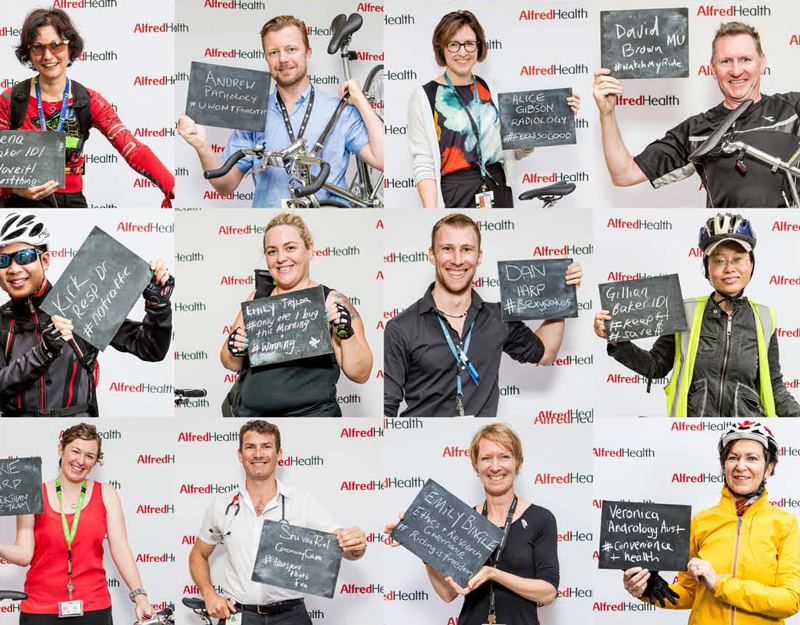The stand-out health and wellbeing benefits for employees of riding to work make it a goal worth pursuing for companies. Simon Vincett reports some inspiring examples.
“Rather than being a health service that waited for people to become affected by illness, disease and injury, about five years ago our organisation decided it wanted to get a whole lot stronger around population health and health promotion,” explains Kirstan Corben of Melbourne’s Alfred Health.
That meant doing everything possible to promote good health to the 8,500 Alfred Health staff and the employees of other organisations on The Alfred Hospital site. Increasing active transport was an obvious avenue to pursue.
“We know from surveying our staff that the majority of staff who do use active transport to get to and from our sites do so for health reasons and are very much motivated by the health gain,” explains Corben.
“We’re a big site with a lot of people and we have always got problems meeting the demand for car parking,” she points out. “We typically have more than 300 bikes at The Alfred every day and we need to provide suitable facilities for those bikes and the people who ride then with the end-of-trip facilities people need.
“I did a lot of work with Bicycle Network and we looked at our current facilities and did an audit of usage on different days and where people were coming from. We looked at other end-of-trip facilities such as showers and change rooms and lockers.
“We did some big consultation processes with our staff as well: why they ride and why they don’t ride, the types of things that will make sure they’ll keep riding and the things that might make them start riding. We got people to prioritise lots of different potential improvements. We also had some other processes that involved about 30 staff more intensively.
“That led us to convert some of our space in our multi-level car park for staff. We converted 19 car spaces into this new facility called the Active Travel Zone. That includes 300 secure bike parks and 300 lockers, showers and change rooms. We opened it up in September to that group of 30 people first and gave them a couple of weeks first to be using it to see what works, what doesn’t, what things need to be adjusted before we opened it up to everyone.”
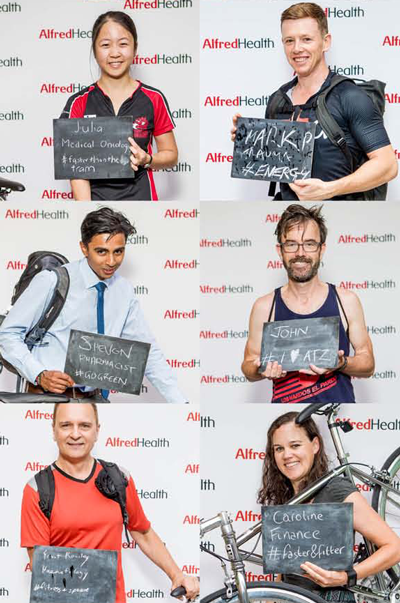
So what did Alfred Health learn from the process?
“Little things that people tells us make a difference is providing towels. For us it was not a big deal to organise but it makes a massive plus for people who use that facility. The way we’ve done it has helped new people to ride, we’ve got feedback from people who used to ride but now they ride more frequently because they’ve got lockers and they can leave their clothes there. They might ride five times a week now where previously they rode twice a week.
“We’ve got a pretty even split of male and female and we’ve got a pretty even split between what we call elite cyclists and those who’d be a bit more utility-type cyclists. That was really important to us for how we built the facility, with the proportion of hanging racks and floor-based racks to cater for the different types of people that we had and the different types of bikes.
“I think those things are very important. We’ve got a floor-based pump that is really useful to people. It’s not that it’s used a lot but when you need it it’s there. We’ve got a water cooler in there to top up your bottle before or after your ride. We’ve got an iron in the change room. We’ve got hair dryers and hair straighteners. Surprisingly these little details are often the things that people talk the most about.
“Right now we’re looking at engaging bike mechanics services to come on site. We’re consulting with our staff and it’s looking like 86% are likely to take that up.
“We’ve done some less formal things around trying to help others understand those who the staff are that ride. We’ve done a few launch events and Ride2Work events where we’ve got a lot of people congregated who have ridden in and lots of people who might be interested. We’ve got lots of pictures of staff holding a little blackboard displaying a hashtag of why they ride. We’re putting those up in different places around the organisation. Doing that makes people aware, for instance ‘Oh, Gavin rides. He’s in my area. I might talk to him about how to do that.’”
In this way The Alfred is facilitating the natural process of people finding their own way and encouraging each other.
“There’s a lot of informal community support within the cyclist group,” explains Corben. “They all talk to other people about it and they all support other people to take it up. There are a few women for instance that I have helped to go and buy bikes because even that can be a bit threatening if you’re not confident.
“You talk to this person and that person and you put them in touch. Often someone’s worked out a really good way to get here – with a focus on trying to be as off-road as possible – and where these paths connect and how you can go through parkland.”
Consulting seems key to success, and on-going communication.
“We’ve focused very strongly on trying to be participatory – even with our capital planning we had input from people to try to make it work,” says Corben.
“Because we’ve got a secure facility it’s got electronic access. People’s ID is their access to get in and out. That helps us to know who the cyclists are. There are about 450 people who are registered users of the Active Travel Zone and in one email I can communicate with all 450 and let them know some news or consult with them about arranging bike mechanic services. Communication now is far easier.”
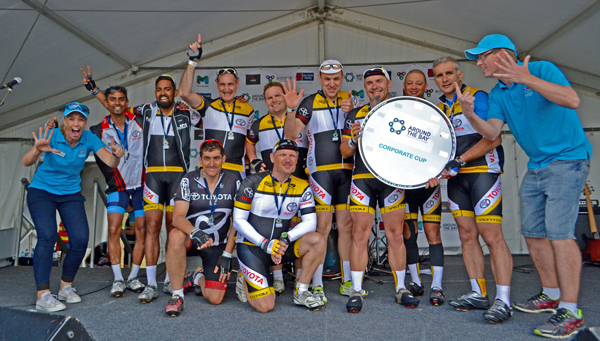
A large company making the most of the camaraderie that cycling can offer is Toyota Australia. With 90 riders in Around the Bay – Ride for a Child in Need in 2015, Team Toyota TACT is a proud winner of the event’s Corporate Cup.
Carlo D’Angelo, organiser of the team for Toyota, explains, “Even though it is a challenge to project manage the team, the many riders and their riding levels and its complexities with logistics and uniform orders for the many riders we have (often between 150–200), it’s always very rewarding and a personal internal feel-good factor when it all comes together on the day.
“I very much enjoy the physical feeling of being really fit, lean and light after completing the Bay ride challenge. It would be nice to say it’s purely altruistic but that would not be entirely correct. It’s also a welcome relief to finish another long 210km ride and know that all the Toyota TACT riders have completed their personal challenge safely.
“I get a buzz out of enticing new riders into the event in doing one of the entry level rides for the first time and then seeing them progress into the greater distance rides the following years. I enjoy reading the feedback and comments I get to read and hear from riders who also feel over the moon about their own success and challenge.”
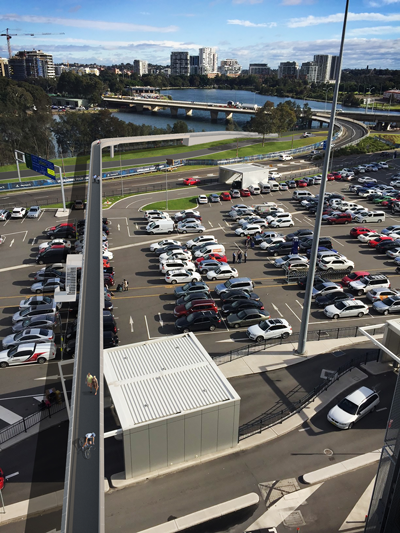 In the last two years there’s been a step change in provision of active transport access to the Sydney Airport by its managing authority. The Sydney Airport Corporation manages the entire airport precinct, with its 800 businesses and 29,000 workers.
In the last two years there’s been a step change in provision of active transport access to the Sydney Airport by its managing authority. The Sydney Airport Corporation manages the entire airport precinct, with its 800 businesses and 29,000 workers.
The Sydney Airport Corporation sees the benefit of providing healthier transport choices for staff for the improvement of their wellbeing and motivation. This re-focussing also reflects the rapid rise in the popularity of bike riding for transport in inner-Sydney.
According to research by the Corporation, more than half of the airport’s workers live close enough to be able to ride to work, so the Corporation has re-examined what it can do to provide easy, safe and efficient active transport access to both its international and domestic terminals.
The Airport provides a storage room and change room facilities for staff and hosts bike maintenance workshops. National Ride2Work Day is celebrated with special shirts and a goody bag for riders. Sydney Airport also fields a team in the annual Sydney to the Gong challenge ride each year, with sponsorship for up to 50 riders in full Sydney Airport kit.
In 2015 the Corporation established a Sydney Airport Cycling Forum to encourage active transport for workers across the whole of the airport, not just the corporation staff. The Forum brings together local and peak cycling groups and government agencies of RMS, Transport for NSW, local councils and the state Department of Health to coordinate input to developing cycling in the airport precinct.
One such development was taking the opportunity, while reconfiguring the vehicular entrance to the domestic terminal precinct, to include provision for active transport, making it easier to come and go by bike. This work includes installing dedicated bike racks in the ground floor of the domestic P1 car park. The work is scheduled for completion by the end of 2016.
But the monumental new initiative is a shared path flyover for pedestrians and bike riders to access the international Terminal 1. This path will take cyclists and pedestrians over the T1 outdoor car park and directly into bicycle storage on level one of the multi-storey car park. From there is easy access to lifts and escalators and the Arrivals and Departures levels of the T1 terminal.
“Sydney Airport is committed to improving access to the airport for cyclists and pedestrians by providing better, safer and more convenient dedicated pathways,” General Manager Parking and Ground Transport Craig Norton says.
“When completed, we expect the new above-ground shared pathway to be used by commuting airport staff, contract workers, local residents and airline passengers staying in hotels in Wolli Creek and Tempe.”
The new pathway is expected to be completed in May 2017 and forms part of Sydney Airport’s Ground Access Solutions investment program to make it quicker and easier to get to and from the airport.
The Airport is also working with the NSW and local governments to ensure effective linkages between on-airport pedestrian/cyclist shared paths and the off-airport cycling network.
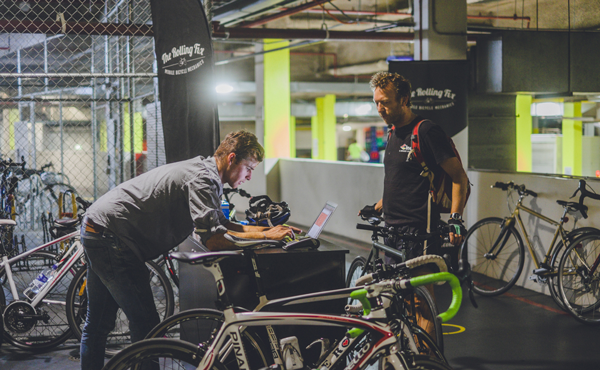 The convenience of having your bike serviced at your workplace has emerged as a major factor in encouraging people to ride to work. The Rolling Fix is a mobile mechanic service that provides just that.
The convenience of having your bike serviced at your workplace has emerged as a major factor in encouraging people to ride to work. The Rolling Fix is a mobile mechanic service that provides just that.
The company operates in Sydney and Melbourne, co-founder Thomas Treloar explains. “We started about three years ago to fix bikes for our mates and we read an article about an end-of-trip facility where they have a bike cage and showers. We saw lots of bikes in one spot and thought it makes sense to fix them there.
“We’ve focussed the entire business on that. We’re taking the servicing to the cyclists and making it easy for them.
“We work directly with building management or companies to provide servicing in the building and that’s available once a month generally to the tenants, who pay for it themselves. In major cities like Sydney, Brisbane and Melbourne there are a lot of different businesses inside the one building – it’s the easiest way to do it.”
A regular schedule of mechanic visits works best for riders, companies have found.
“All of our buildings are on a contract for once a month or quarterly,” says Treloar. “Every now and then we do a one-off but most of the time we do a bike cage launch and then go in there consistently to provide servicing as an ongoing thing. There’s nothing worse than getting a taste of something good and then they take it away from you!”
Once the relationship is established, however, there’s a bit of give and take.
“If you get a flat tyre on the way to work we come in and it’s just an emergency call-out fee to fix your flat tyre.”
The guys can advise on keeping you bike in good shape for the most enjoyable riding.
“It tends to be that people get their bike serviced when something goes wrong,” Treloar explains. “If you let your chain and cassette go too long it’s a much more expensive process to than just replacing the chain. Over time it gets worse and worse and before you know it it’s running pretty poorly.
“People think their bike needs a service once a year but it’s a lot better to do it more often.”
Staff who want to use the service generally have two options, to book in through the Rolling Fix website or they can turn up on the day. There are posters provided to put up and communication that goes out through the building a week or two weeks prior to the service day.
There’s rarely an issue the mobile set-up can’t handle.
“We’ve got a couple of vans with lots and lots of parts that can service about 90 per cent of bikes and can do everything the bike needs,” says Treloar. “Quite often people think ‘Oh they’re just a little van – they can’t do everything’, but we can. We’ve got all the tools. Obviously there are anomalies and even bike shops struggle to have everything in stock. We do our best to have everything needed for the average commuter.”
Treloar suggests one of his mechanics can handle eight bikes in an average day but says “We’ve done up to 60 bikes in a day at a cage launch with plenty of staff.”
As a bit of an expert on the subject, Treloar has some insights into what a good bike lock up can be like: “The cage is not chicken wire, they’re wood. The bike racks are nice colours and they have murals all over the walls. It’s well lit and there’s plenty of space so your bike’s not going to get damaged. It’s a pretty nice environment to finish your ride. You tie that in with a nice shower and locker facility with fresh towels and it becomes a pretty good option for getting to work. Taking away the enjoyment, it’s easy. If you work at a building that doesn’t have that the logistics of riding a bike become a bit more complicated.”
7 keys to cycling success
- Fresh towels – along with an iron and a hair straightener, these things make your locker room a stand-out
- Team jersey – builds a sense of teamwork that bridges hierarchical divides
- Visiting mechanic – takes all the hassle out of bike servicing
- Jazz up the bike parking – with good lighting and nice colours a secure cage can be a pleasant space too
- Get social – maintain a Facebook group or intranet communications to share and organise
- Celebrate – with a Ride2Work Day breakfast and your own active travel events
- Listen – ask your workmates what they want: social rides, skills training, bike shop discounts, ebike test rides …
National Ride2Work Day 2016 is on Wednesday 12th October. Find out more or register at ride2work.com.au.
Ride On content is editorially independent, but is supported financially by members of Bicycle Network. If you enjoy our articles and want to support the future publication of high-quality content, please consider helping out by becoming a member.

